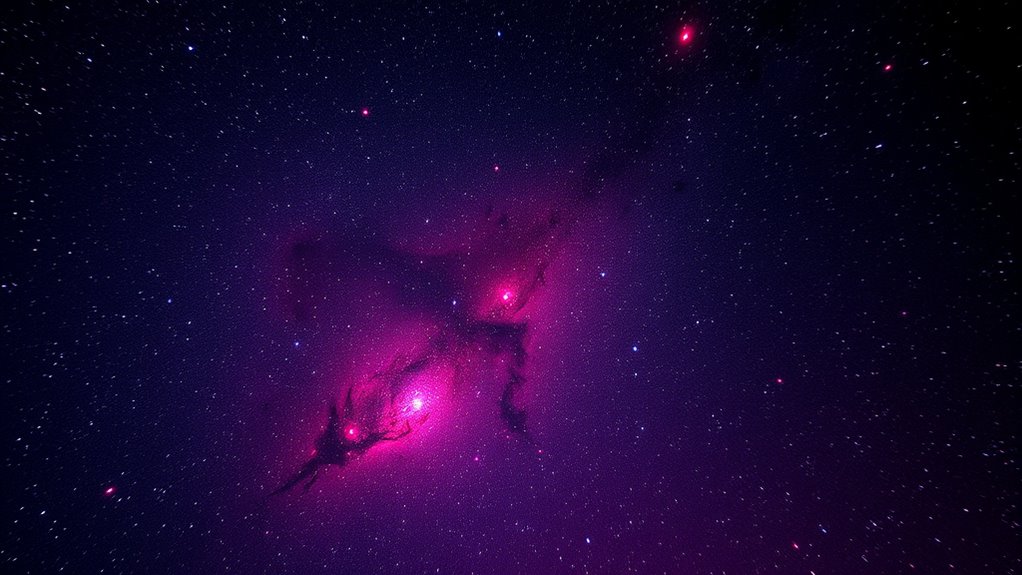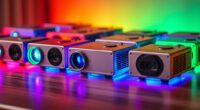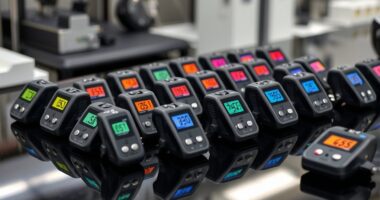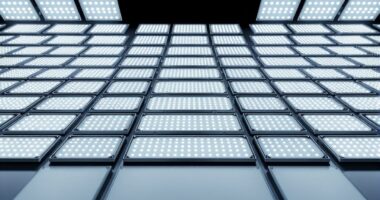If you’re looking to elevate your astrophotography, I’ve found that the best infrared filters, like UV/IR cuts, narrowband, and multi-pass options, can really enhance detail and contrast beyond visible light. These filters block unwanted UV and IR wavelengths while boosting celestial features. Whether you’re aiming for vivid nebulae or sharp planetary images, choosing the right filter matters. Keep exploring, and you’ll discover more about selecting the perfect infrared filter for your stellar shots.
Key Takeaways
- Infrared filters enhance astrophotography by blocking unwanted UV/IR light, increasing contrast, and revealing vivid celestial details.
- Narrowband IR filters target specific wavelengths like H-alpha and O-III for detailed nebula imaging.
- High-quality IR filters with high transmission rates (around 95%) improve sharpness and color accuracy in stellar shots.
- Specialized filters such as SVBONY IR pass and adjustable 6-in-1 IR filters offer versatile options for creative astrophotography.
- Compatibility with various camera and telescope accessories ensures ease of integration for elevated astrophotography results.
SVBONY UV IR Cut Filter for Astrophotography CCD Cameras
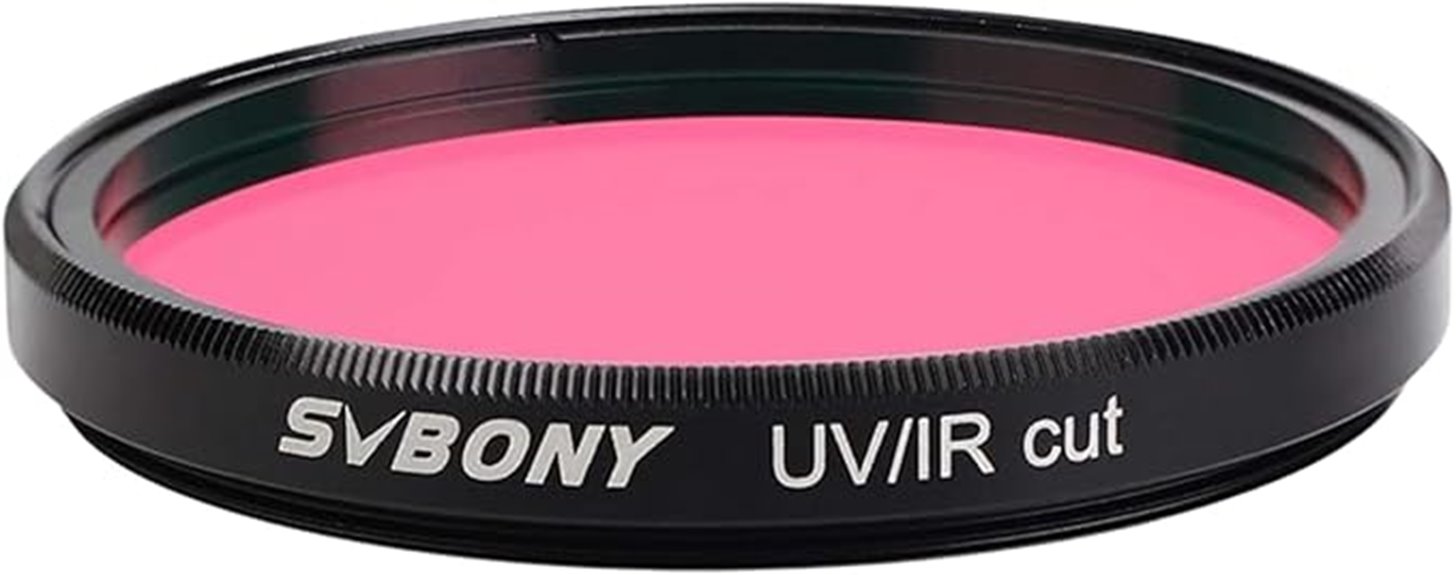
If you’re serious about capturing clear, high-contrast astrophotos, the SVBONY UV IR Cut Filter is an excellent choice for CCD cameras and telescope accessories. It features 2-inch threads compatible with DSLR cameras, CCDs, modified WebCams, and telescopes. The advanced coating technology blocks ultraviolet and infrared rays that can interfere with image quality, resulting in sharper images with natural colors and subtle gradation. This filter reduces ghost images and enhances contrast and detail, serving as a durable lens protector. Compact and lightweight, it comes with a protective plastic box, making it a reliable, versatile tool for improving your astrophotography.
Best For: amateur and professional astrophotographers seeking high-quality UV/IR filtration to improve image clarity and detail with CCD cameras and telescope accessories.
Pros:
- Utilizes advanced coating technology for durable, high-quality filtration that blocks unwanted UV and IR rays
- Compatible with a variety of cameras and telescope accessories due to its 2-inch threading
- Reduces ghost images and enhances contrast, sharpness, and natural color gradation for stunning astrophotos
Cons:
- Slightly more expensive than basic filters, which may be a consideration for budget-conscious users
- Requires careful handling to avoid scratches or fingerprints that could affect optical performance
- Not compatible with cameras or accessories that do not have 2-inch threading or are outside the specified specifications
SVBONY SV240 Telescope Filter, 2 Inches Multi-Narrowband Galaxy Nebula Filter
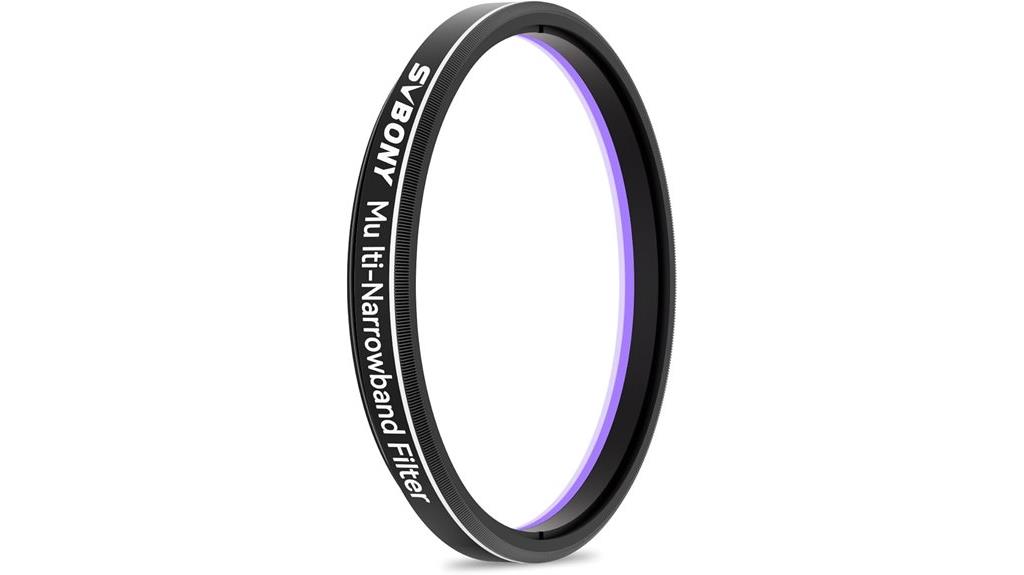
The SVBONY SV240 Telescope Filter stands out as an excellent choice for astrophotographers who want a versatile, multi-bandpass filter that works seamlessly across most systems. Its 2-inch design covers wavelengths from 300 to 1100 nm, ideal for capturing galaxies and nebulae even in urban light pollution. With over 90% transmittance at key wavelengths like Ha, OIII, and H-Beta, it enhances brightness and detail. Its high compatibility eliminates the need for multiple filters, making it a practical solution. Although some users report halos and star bloating in extreme light pollution, overall, it’s a reliable, effective tool for city astrophotography.
Best For: amateur astrophotographers seeking a versatile, multi-wavelength filter suitable for urban light-polluted environments to capture galaxies and nebulae with enhanced contrast and detail.
Pros:
- High compatibility with 99% of astrophotography systems, eliminating the need for multiple filters.
- Effective light pollution blocking with a cut-off depth of ≥OD4, suitable for city-based astrophotography.
- Wide wavelength coverage (300-1100 nm) with high transmittance (>90%) at key nebula and galaxy emission lines.
Cons:
- Potential halos and star bloating from infrared transmission, especially in high light pollution areas.
- Less effective for planetary imaging due to its spectral properties focused on nebulae and galaxies.
- Some users experience reflections and star bloating issues in extreme light pollution conditions (Bortle 8-9).
SVBONY 1.25-inch UHC Telescope Filter
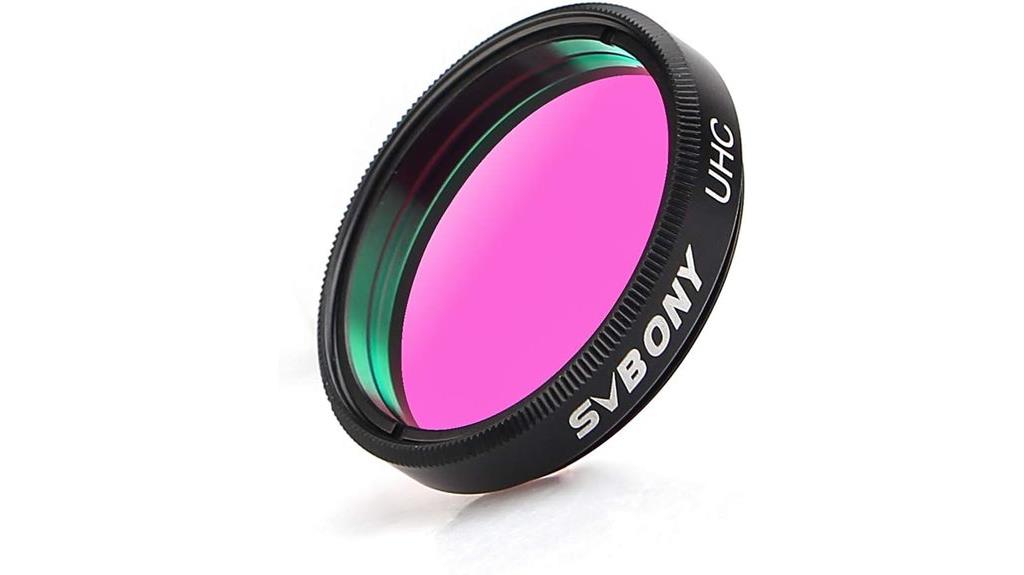
For amateur astronomers seeking an affordable yet effective filter, the SVBONY 1.25-inch UHC Telescope Filter stands out as a top choice. It reduces light pollution and enhances contrast, especially in urban areas with artificial lighting. Made with optical glass and an aluminum frame, it’s compatible with most eyepieces and accessories. Users report sharper, clearer images of nebulae like M17, even under light-polluted skies. Perfect for both visual observation and astrophotography, it allows long exposures and stacking for detailed images. Priced around $20, it offers performance comparable to higher-end filters, making it a smart, budget-friendly investment for serious stargazers.
Best For: amateur astronomers and astrophotographers seeking an affordable, effective filter to improve visibility and image quality of nebulae in light-polluted environments.
Pros:
- Enhances contrast and reduces light pollution, making faint nebulae more visible.
- Compatible with most 1.25-inch eyepieces and accessories, easy to use.
- Excellent performance for the price, comparable to higher-end filters.
Cons:
- Slight violet tint or minor detail loss in some observations.
- Not suited for professional or high-end astrophotography needs.
- Limited to 1.25-inch size, may not fit larger telescope setups.
GREEN.L 49mm Infrared Filter, 49mm IR 720nm (R72) Filter for Camera Lens
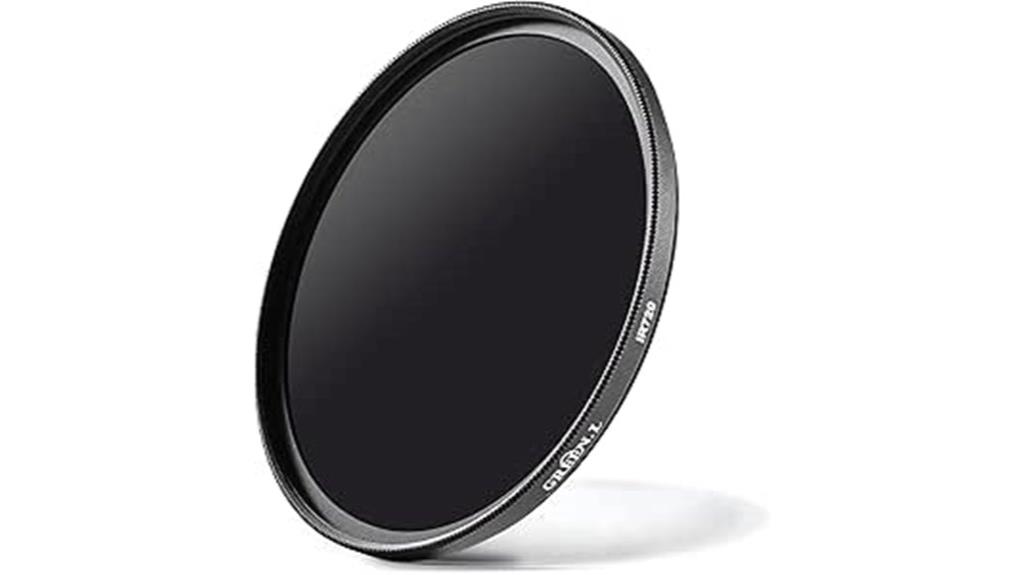
Photographers looking to explore unique infrared effects will find the GREEN.L 49mm Infrared Filter (R72) an excellent choice. This filter blocks visible light and UV, creating striking images with a surreal, glowing quality. Made from high-quality optical glass with a 9HD hardness, it’s scratch-resistant and built to last, while the aviation aluminum frame adds durability. Compatible with any 49mm threaded lens, it’s easy to attach. Just remember to set a custom white balance, switch to manual mode, and adjust exposure for best results. Longer exposures are often necessary, but the stunning infrared effects make the effort worthwhile for both creative and analytical photography.
Best For: photographers and analytical professionals seeking to capture unique infrared images with surreal effects and enhanced clarity.
Pros:
- Made from high-quality optical glass with 9HD hardness for scratch resistance and durability
- Compatible with any 49mm threaded camera lens for easy attachment
- Enables creative and analytical infrared photography by blocking UV and visible light
Cons:
- Requires manual camera adjustments, including white balance and exposure settings
- Longer exposure times may be necessary, which can be less convenient for quick shots
- Proper setup and compatibility verification are essential for optimal results
Optolong UV/IR Cut Filter – 2
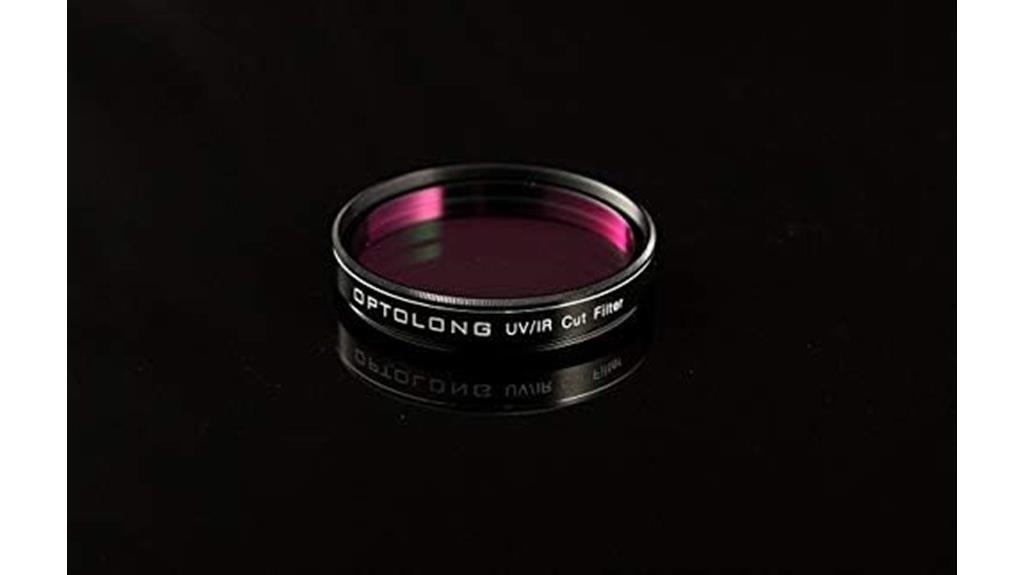
If your digital camera or video device lacks built-in IR protection filters or has been modified, the Optolong UV/IR Cut Filter – 2 is an essential accessory. It blocks ultraviolet and infrared wavelengths, boosting image sharpness and clarity. Unfiltered sensors are vulnerable to UV and IR rays outside the visible spectrum, which can distort images. This small, lightweight filter guarantees better focus by preventing these wavelengths from reaching the sensor, making it ideal for cameras not designed to handle IR and UV light. Rated 4.4 stars and ranked highly in infrared filters, it’s a reliable choice for enhancing your astrophotography and stellar shots.
Best For: digital camera and video device users who want to improve image sharpness by blocking UV and IR wavelengths, especially if their equipment lacks built-in IR protection filters or has been modified.
Pros:
- Effectively blocks ultraviolet and infrared light to enhance image clarity and focus.
- Small and lightweight design makes it easy to install without adding bulk.
- Compatible with a wide range of digital cameras and video devices, improving overall image quality.
Cons:
- Requires manual installation, which may be challenging for beginners.
- Does not include additional optical features like polarization or color correction.
- May be an additional expense for users who already have IR filters built into their camera systems.
SVBONY SV220 Telescope Filter, 7nm Dual-Band Nebula for Astrophotography
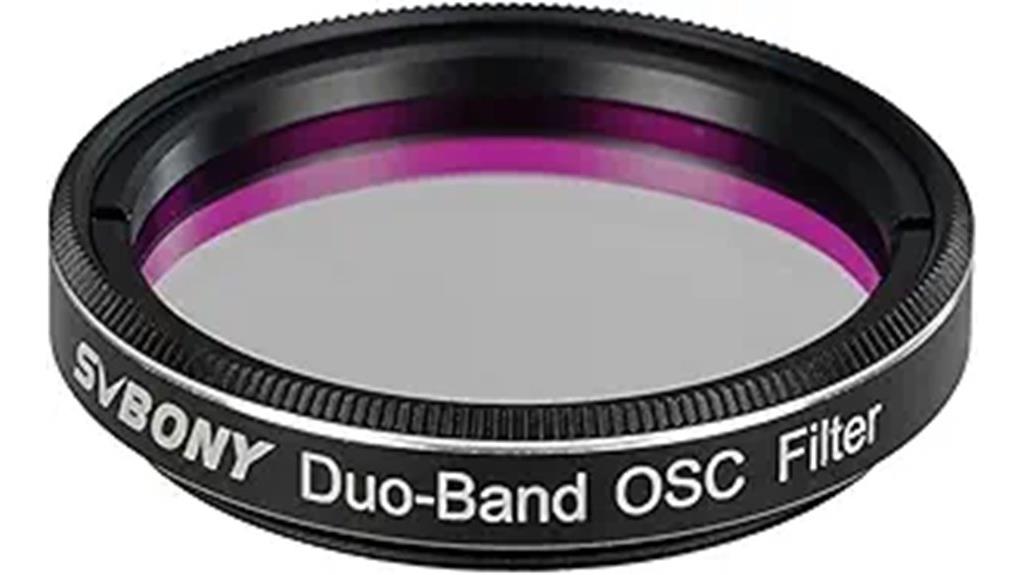
The SVBONY SV220 Telescope Filter, with its 7nm dual-band design targeting H-Alpha and O-III wavelengths, stands out as an excellent choice for astrophotographers who want to capture nebulae with enhanced contrast and clarity. It effectively reduces light pollution from moonlight and artificial sources, allowing for clearer imaging even in urban environments. This filter boosts the contrast of gaseous nebulae, making them more visible without brightening them, which helps produce stunning, high-contrast images. Its compatibility with one-shot color cameras and ease of use make it a versatile tool for deep-sky astrophotography under various sky conditions.
Best For: amateur and professional astrophotographers seeking to capture high-contrast nebula images in light-polluted urban environments.
Pros:
- Effectively reduces light pollution for clearer deep-sky imaging
- Enhances nebula contrast without brightening, resulting in high-quality images
- Compatible with one-shot color cameras and easy to use in various sky conditions
Cons:
- Narrowband filters may require longer exposure times for optimal results
- Limited to H-Alpha and O-III wavelengths, not suitable for all astrophotography targets
- May be more expensive compared to broad-spectrum filters for general use
Hoya 77mm R-72 Infrared Filter
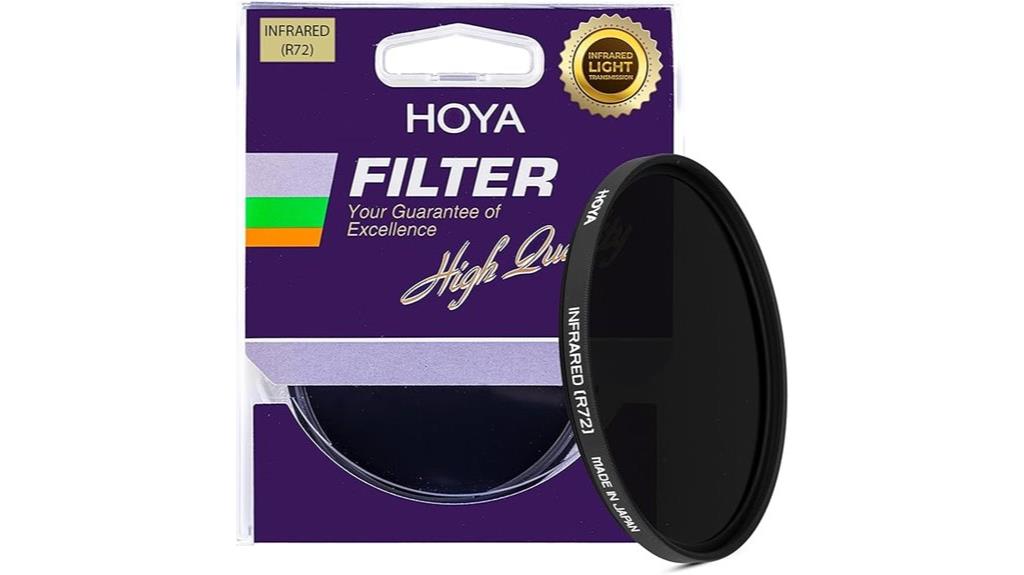
For those seeking to open stunning infrared effects with their DSLR or mirrorless camera, the Hoya 77mm R-72 Infrared Filter stands out as an excellent choice. It allows infrared light above 720nm to pass through, enabling vivid red tones, striking black-and-white contrasts, and creative surreal images. With 95% light transmission between 760nm-860nm, it delivers sharp, clear, and high-contrast results. Compatible with various Hoya filters and accessories, it offers flexibility for different styles. Durable and well-crafted, this filter helps transform ordinary shots into extraordinary visuals, making it a versatile tool for infrared photography enthusiasts seeking to push their artistic boundaries.
Best For: photographers and enthusiasts looking to explore stunning infrared effects, surreal images, and high-contrast black-and-white photography with their DSLR or mirrorless cameras.
Pros:
- Allows infrared light above 720nm to pass, enabling vivid red tones and striking contrasts
- High 95% light transmission between 760nm-860nm ensures sharp, clear images with rich detail
- Compatible with various Hoya filters and accessories for versatile creative options
Cons:
- May require long exposure times due to infrared light blocking, necessitating sturdy tripod support
- Not suitable for standard visible-light photography without removing or bypassing the filter
- Can be challenging for beginners to master infrared camera techniques and post-processing
Fotga 58mm Adjustable Infrared IR Pass Lens Filter
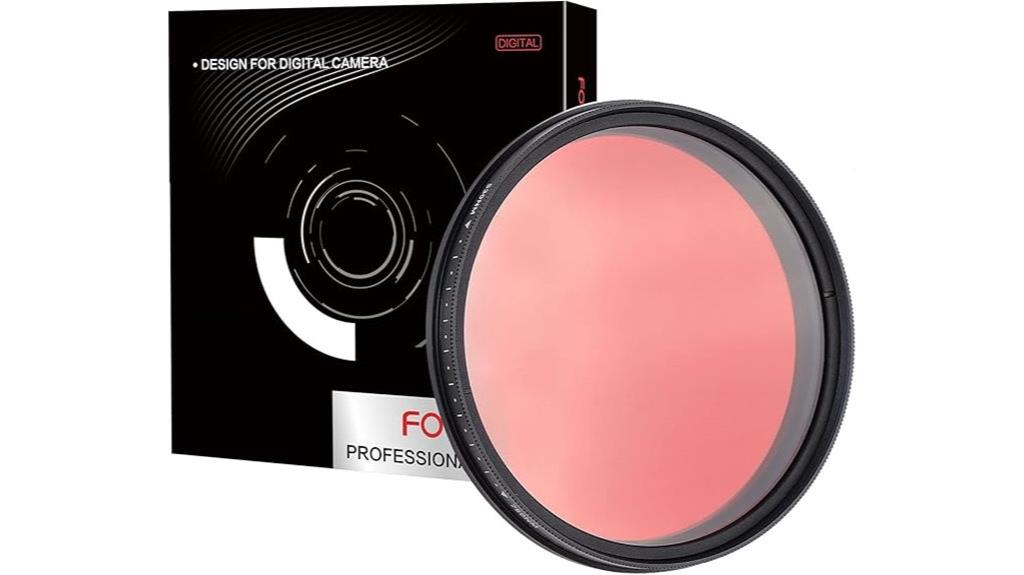
The Fotga 58mm Adjustable Infrared IR Pass Lens Filter stands out as an excellent choice for photographers wanting versatile, adjustable IR effects without investing in multiple filters. Its six-in-one design allows you to tweak infrared wavelengths from 530nm to 750nm by twisting the filter, making it highly adaptable for landscape, plant, and creative photography. Made from optical glass with a durable metal ring, it offers sharp images without affecting focus. While some users report issues like muddy colors or vignetting at higher densities, many appreciate its affordability, convenience, and ability to produce dramatic IR effects on full-spectrum or converted cameras.
Best For: photographers seeking a versatile, adjustable IR filter to experiment with infrared effects on DSLR cameras without investing in multiple filters.
Pros:
- Adjustable infrared wavelength range from 530nm to 750nm for versatile IR effects
- Made from optical glass with a durable metal ring for sharp, focus-preserving images
- Cost-effective alternative to multiple single-purpose IR filters, suitable for creative and landscape photography
Cons:
- May produce muddy colors, banding, or vignetting at higher density settings
- Image quality can be inferior compared to dedicated IR filters, especially on normal or unconverted cameras
- Variable density mechanism (polarizing-based) can reduce light passing and cause image degradation
6 in 1 Infrared IR Pass X-Ray Lens Filter for DSLR Cameras
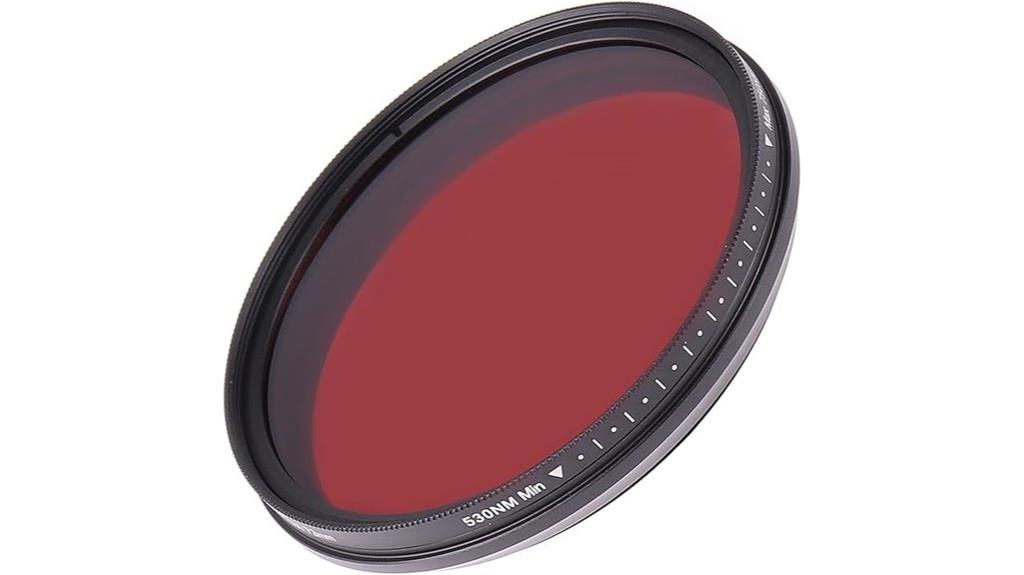
If you’re looking to explore infrared photography without investing in expensive, specialized filters, the 6-in-1 Infrared IR Pass X-Ray Lens Filter is an excellent choice. Compatible with Canon, Nikon, Sony, and other DSLR cameras, it features adjustable wavelengths from 530nm to 750nm, allowing you to fine-tune your IR shots. Its six-in-one design replaces multiple filters, making it versatile and convenient. Made from optical glass with a metal ring, it’s durable and easy to use. Whether capturing surreal landscapes or revealing hidden details, this filter offers a budget-friendly way to experiment with infrared imaging and expand your creative possibilities.
Best For: hobbyist photographers, beginners, and budget-conscious shooters interested in experimenting with infrared photography and creative imaging effects.
Pros:
- Adjustable wavelength range (530nm to 750nm) for versatile IR effects
- Replaces multiple filters with a single, 6-in-1 design, offering convenience and cost savings
- Compatible with various DSLR brands and camcorders, making it widely usable
Cons:
- May require camera modifications or sensor adjustments for optimal results
- Image quality can vary at higher wavelengths, sometimes needing post-processing
- Basic adjustment mechanism might limit precise control for advanced users
FocusFoto FOTGA 67mm Adjustable Infrared IR Pass Filter

Designed with versatility in mind, the FocusFoto FOTGA 67mm Adjustable Infrared IR Pass Filter is ideal for beginners and hobbyists exploring infrared astrophotography. It offers adjustable control over wavelengths from 530nm to 750nm, allowing customization for different scenes and lighting conditions. Its optical glass and metal ring construction ensure durability and clear images. The filter’s adjustable feature eliminates the need for multiple filters, making it convenient for indoor and outdoor use. While some users note limited wavelength markings and reduced light transmission at certain settings, overall, it provides a flexible, easy-to-use entry point into IR photography for those starting out.
Best For: hobbyists and beginners interested in exploring infrared photography and astrophotography with adjustable control over IR wavelengths.
Pros:
- Adjustable wavelength control from 530nm to 750nm for versatile shooting options
- Durable optical glass and metal construction ensure longevity and clear images
- Convenient all-in-one design eliminates the need for multiple filters, ideal for various indoor and outdoor conditions
Cons:
- Limited wavelength markings may cause uncertainty in precise adjustments
- Reduced light transmission (~40%) at certain settings, requiring higher ISO or longer exposures
- Some users report only specific wavelengths (e.g., around 650nm and 750nm) work optimally with their cameras, affecting consistency
SVBONY SV183 Telescope Filter, IR Pass Filter, 1.25 Inch
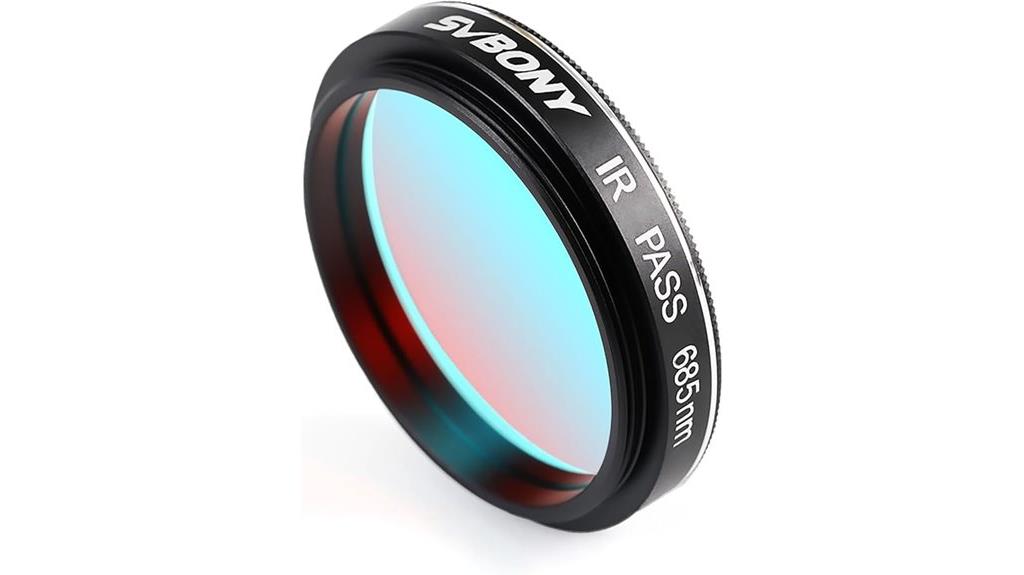
Astrophotographers seeking to improve planetary and lunar images under less-than-ideal seeing conditions will find the SVBONY SV183 IR Pass Filter a valuable tool. This 1.25-inch filter effectively blocks visible light, enhancing contrast by reducing atmospheric turbulence effects. Its sturdy CNC-machined aluminum frame and super-thin cell ensure durability and a clear 26mm aperture. Compatible with standard 1.25-inch devices and M48 threaded accessories, it’s versatile for planetary, lunar, and deep-sky imaging. Users report noticeable improvements in detail and contrast, especially in challenging conditions. Overall, the SVBONY SV183 offers a reliable, high-quality option for astronomers aiming to capture sharper, more detailed celestial images.
Best For: amateur and professional astronomers aiming to enhance planetary and lunar imaging under poor seeing conditions using IR pass filtering.
Pros:
- Effectively blocks visible light to improve contrast and detail in images
- Durable CNC-machined aluminum frame ensures longevity and stability
- Compatible with standard 1.25-inch and M48 threaded accessories for versatile use
Cons:
- Slight dirt spots on the glass may require cleaning for optimal performance
- Delivery delays or availability issues could affect immediate use
- Some users may need additional adapters for specific equipment configurations
20pcs IR-Cut Blocking Filters for Camera Sensors
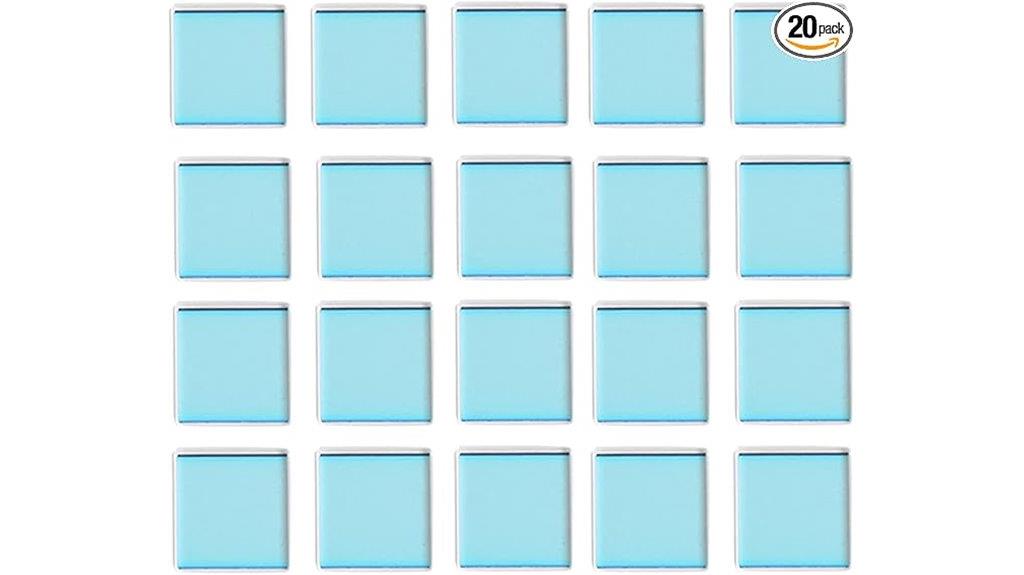
These PCS IR-Cut blocking filters are ideal for anyone aiming to capture natural, distortion-free images with their cameras. Each set includes 20 small, square filters measuring 8mm×8mm×0.55mm, designed to block infrared light above 650nm while passing visible light from 420nm to 620nm. They are multi-coated to guarantee accurate color reproduction and reduce distortions, making them perfect for security cameras, digital cameras, and telescopes. Although discontinued, they remain popular for enhancing daytime image clarity and color accuracy. Easy to install and compatible with various devices, these filters help achieve more natural, vibrant visuals by filtering unwanted IR light.
Best For: photographers, security camera users, and telescope enthusiasts seeking accurate color reproduction and enhanced daytime image clarity.
Pros:
- Blocks infrared light above 650nm to prevent color distortion and improve image quality.
- Multi-coated for precise color accuracy and reduced distortions.
- Compatible with a wide range of imaging devices, including CCTV, digital cameras, and telescopes.
Cons:
- Discontinued by the manufacturer, potentially affecting availability and support.
- Limited to daytime use, as IR cut filters are primarily effective in well-lit conditions.
- Small size (8mm×8mm) may require careful handling and installation.
ICE IR 49mm 49 Slim Filter Infrared Infra-Red 760HB 760nm 760 Optical Glass
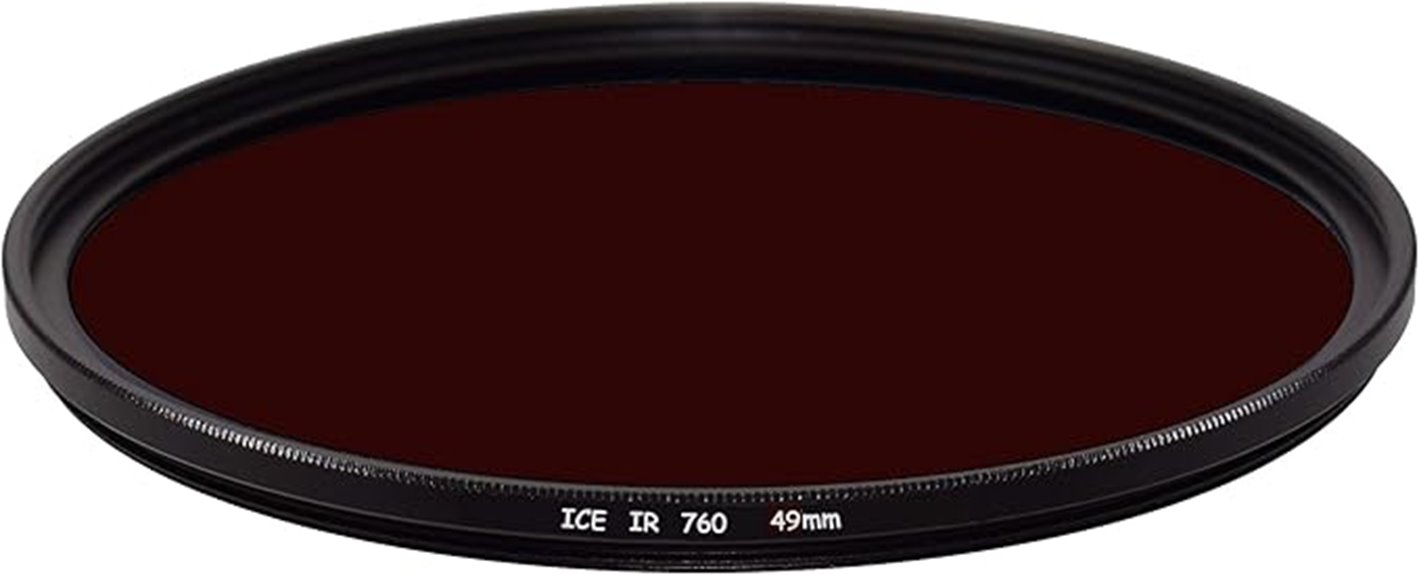
The ICE IR 49mm Slim Infrared Filter stands out as an excellent choice for photographers seeking precise infrared capture without adding bulk to their lenses. Its slim profile, made from high-quality optical glass, is ideal for wide-angle photography, ensuring minimal vignetting. The double-threaded metal frame allows for stacking filters or attaching hoods easily. With a 760nm wavelength, it effectively blocks visible light, enhancing infrared imaging. Weighing just 1.8 ounces, it’s lightweight and unobtrusive. Rated 4.3 stars, this filter offers reliable performance for astrophotography enthusiasts aiming to capture stunning stellar details with clarity and precision.
Best For: photographers seeking a high-quality, slim infrared filter for wide-angle and astrophotography to capture detailed infrared images with minimal vignetting.
Pros:
- Slim profile reduces vignetting on wide-angle lenses.
- Made from high-quality optical glass for clear infrared imaging.
- Double-threaded metal frame allows stacking filters or attaching hoods easily.
Cons:
- Limited to 760nm infrared wavelength, may not suit all infrared photography needs.
- Only weighs 1.8 ounces, which might be too lightweight for some stability requirements.
- Customer ratings are based on a small sample size of 3 reviews.
ICE 100mm x 100 Infrared 720hb Filter Optical Glass IR 720nm
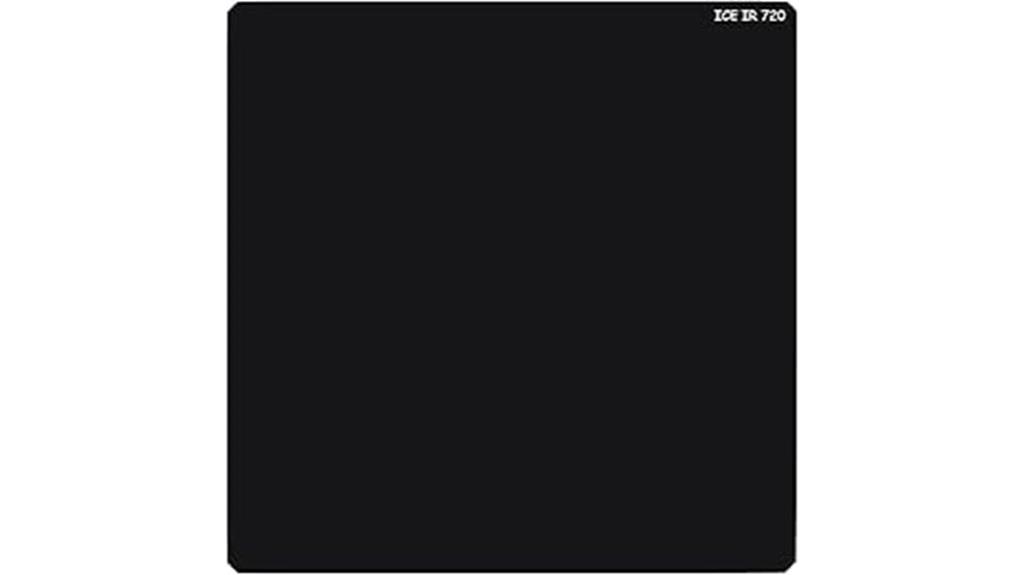
Looking for a reliable infrared filter that delivers crisp, high-quality images at 720nm? The ICE 100mm x 100mm Infrared 720hb Filter is an excellent choice. Made from high-quality optical glass, it guarantees clarity and durability, fitting standard 100mm holders like LEE, Cokin Z, and others. Its 2mm thickness minimizes distortions, and it’s suitable for both amateur and professional astrophotography. Designed to pass only infrared light at 720nm, it creates stunning stellar images. Plus, with a protective plastic case and a solid 5-star customer rating, it’s a dependable tool to elevate your infrared imaging.
Best For: photographers and astrophotographers seeking high-quality infrared images at 720nm, suitable for both amateur and professional use.
Pros:
- Made from high-quality optical glass ensuring clarity and durability
- Fits standard 100mm filter holders like LEE, Cokin Z, and others for versatile compatibility
- Designed to pass only infrared light at 720nm, producing crisp, stunning stellar images
Cons:
- Requires proper shading to prevent flare and unwanted reflections during long exposures
- Slightly opaque to the naked eye, which may require adjustments in handling and setup
- May cause ghosting or artifacts if lens tilt-shift effects are not managed properly
ICE Slim IR Filter Infrared Infrared 760HB 760nm 760 Optical Glass (58mm)
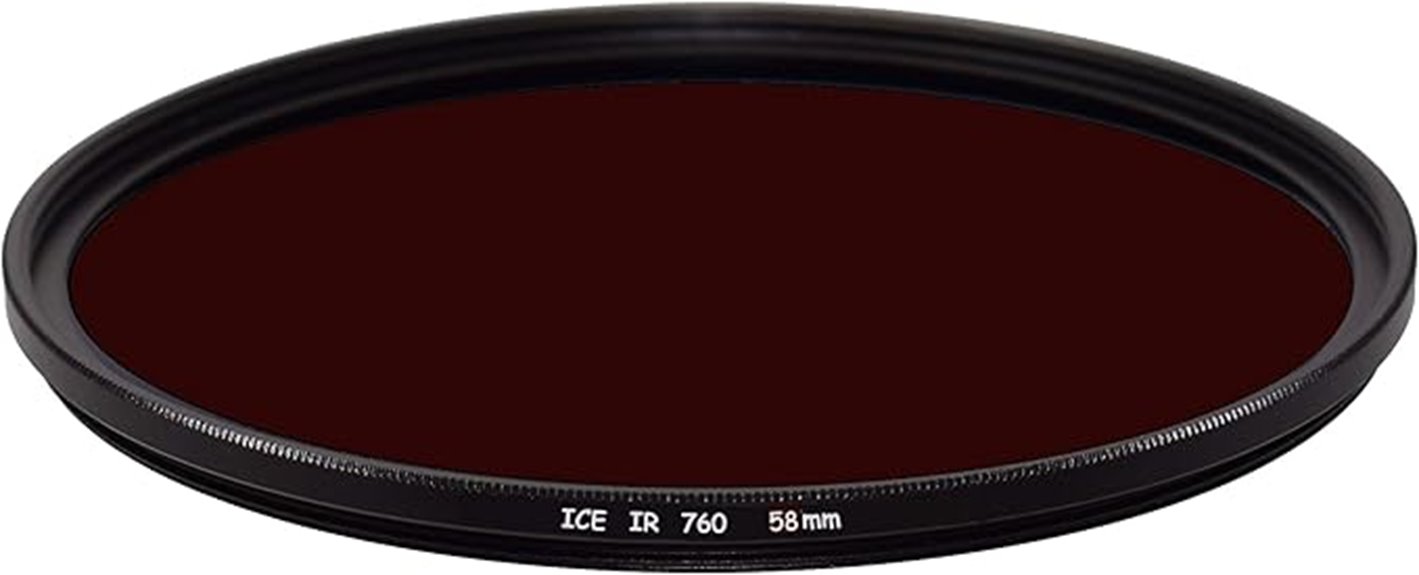
If you’re using wide-angle lenses for infrared astrophotography, the ICE Slim IR Filter Infrared 760nm is an excellent choice because its slim profile guarantees vignetting and guarantees compatibility with various optical setups. Made of high-quality optical glass, it passes infrared light at 760nm while minimizing reflections with a black-rimmed design. Its superfine matte black frame is only 3.6mm deep, allowing stacking with other filters or hoods. The screw-in design and front threads add versatility, and the lightweight build (just 1.6 ounces) makes it easy to handle. Packaged in a protective case, this filter is a reliable addition for capturing stunning infrared astrophotos.
Best For: astrophotographers and photographers using wide-angle lenses who want to capture detailed infrared images at 760nm.
Pros:
- Slim profile minimizes vignetting on wide-angle lenses, ensuring clear images.
- Made of high-quality optical glass with black-rimmed design to reduce reflections.
- Versatile screw-in design with front threads allows stacking with other filters or hoods.
Cons:
- Customer ratings are moderate at 3.5 out of 5 stars, indicating mixed reviews.
- Limited to infrared light at 760nm, which may not suit all infrared photography needs.
- The product’s lightweight and compact design, while portable, may require careful handling to avoid damage.
Factors to Consider When Choosing Infrared Filters for Astrophotography
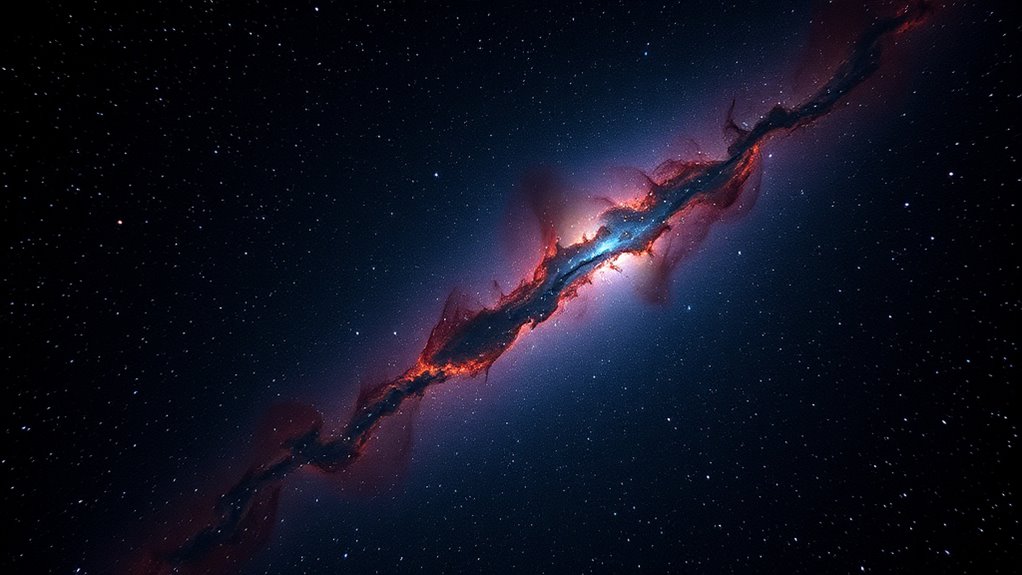
When selecting infrared filters for astrophotography, I consider factors like wavelength specificity, optical clarity, and compatibility with my camera gear. Durability, material quality, and budget also play key roles in making the right choice. Understanding these points helps me find a filter that delivers clear images while fitting my needs and budget.
Wavelength Specificity
Choosing the right infrared filter hinges on understanding its wavelength specificity, which directly impacts the quality and type of astrophotography results. Infrared filters are designed to pass particular wavelengths, such as 720nm or 760nm, targeting specific emission lines from celestial objects or atmospheric features. Narrowband filters transmit a very precise wavelength with a narrow FWHM, allowing for detailed spectral imaging. Wideband filters, in contrast, cover broader IR ranges, offering more general IR captures but less spectral detail. The effectiveness of a filter depends on how well its specified wavelength aligns with the emission lines you’re interested in imaging. Selecting the appropriate wavelength _guarantees_ you capture the desired infrared signals, enhancing your astrophotography with targeted, high-quality results.
Optical Clarity
Optical clarity plays a vital role in maximizing the performance of infrared filters for astrophotography. High-quality optical glass with multi-coatings minimizes reflections and distortions, guaranteeing sharp, detailed images. Using true optical substrates with plane-parallel surfaces reduces ghosting, flare, and chromatic aberration, which can otherwise compromise image quality. Durability is also key; coated filters resistant to scratches maintain clarity over time, preserving your image integrity. High-transmission IR filters allow maximum light throughput at target wavelengths, boosting contrast and detail. Proper filtration of UV and IR wavelengths helps eliminate haze and chromatic distortion, resulting in crisper, more natural celestial images. Overall, selecting optical clarity ensures your astrophotography captures the true beauty of the night sky with precision and sharpness.
Compatibility Range
Selecting an infrared filter that fits your equipment’s specifications is essential for achieving ideal astrophotography results. First, confirm the filter’s thread size matches your camera or telescope’s diameter, like 1.25 inches or 2 inches, for a secure fit. Next, verify that its wavelength transmission range covers your target IR spectrum, typically around 720nm to 760nm, to capture the desired details. It’s also imperative to confirm the filter’s optical coating and glass quality to avoid distortions or reflections that could compromise image clarity. Additionally, check compatibility with your camera sensor—whether CCD, CMOS, or DSLR—to maximize IR light transmission. Finally, consider the filter’s physical dimensions and design features to guarantee seamless integration with your existing accessories and setup.
Durability and Material
Since durability is essential for long-term performance, I look for infrared filters made from high-quality optical glass that guarantees clarity and minimizes distortions during astrophotography sessions. The glass’s physical robustness guarantees consistent, sharp images over time. I also prioritize filters with frames made from durable materials like metal or aviation-grade aluminum, which resist scratches, corrosion, and impacts—important when shooting outdoors. Coating technology, such as multi-coatings or dielectric layers, further enhances resistance to dust, moisture, and UV exposure, protecting the filter’s integrity. A well-designed filter, with a slim profile and double-threaded frame, prevents vignetting and allows safe stacking with other filters or accessories. Overall, sturdy construction and quality materials are key to reliable, long-lasting astrophotography gear.
Price and Budget
Infrared filters for astrophotography come in a wide range of prices, from around $20 for basic models to over $150 for premium options. Budget-friendly filters often have broader wavelength ranges and lower transmittance, which can impact image quality and contrast. Higher-priced filters typically feature better optical coatings, more precise wavelength control, and increased durability, resulting in clearer images and longer lifespan. When choosing within a specific budget, it’s essential to balance cost with optical performance to meet your astrophotography needs. Investing slightly more upfront can be cost-effective over time, as higher-quality filters may require fewer replacements and produce superior images. Ultimately, finding the right filter depends on your budget and the level of detail you want to capture.
Light Pollution Blocking
When choosing infrared filters for astrophotography, one of the most critical factors is their ability to block light pollution effectively. I look for filters with a cut-off depth of at least OD4, which helps eliminate urban skyglow and background illumination. This level of blocking improves contrast and allows me to capture more detailed images, even in areas with significant artificial lighting. Narrowband IR filters that target specific wavelengths, like H-alpha or OIII, inherently block much of the unwanted visible and ambient light, making them ideal for deep-sky objects. The spectral cut-off wavelength also matters—longer wavelengths generally provide better suppression of city lights. Proper light pollution blocking is essential for achieving clearer, more defined images under heavy light-polluted skies, such as Bortle 8-9 environments.
Image Quality Impact
Choosing the right infrared filter can make a noticeable difference in the sharpness and contrast of your astrophotography images. High-quality filters block unwanted UV and IR light that can cause blurring or haze, resulting in clearer details. The quality of the filter’s optical glass and multi-coatings directly influences color fidelity, detail resolution, and minimizes reflections or ghosting. Poorly manufactured IR filters often introduce chromatic aberration or star bloating, which diminishes the sharpness of celestial objects. Filters with high transmittance at specific IR wavelengths, like 720nm or 760nm, improve the visibility of faint deep-sky objects while maintaining contrast. Using filters with true optical quality glass and precise multi-coatings guarantees minimal distortion, maximizing detail and clarity in your astrophotography shots.
Frequently Asked Questions
How Do Infrared Filters Impact Color Accuracy in Astrophotography?
Infrared filters can slightly affect color accuracy in astrophotography by blocking visible light and emphasizing infrared wavelengths. This often results in images with a different color palette, sometimes making stars and celestial objects appear more surreal or monochromatic. I find that using these filters requires some post-processing adjustments to restore natural colors, but they’re excellent for revealing details invisible in regular light, giving your shots a unique, otherworldly quality.
Can Infrared Filters Be Used With Smartphone Cameras?
Yes, infrared filters can be used with smartphone cameras, but there are some caveats. You need a compatible phone with a removable or accessible lens, and often an adapter to attach the filter. Keep in mind, smartphone sensors aren’t optimized for infrared, so results may vary. Still, experimenting with infrared filters on your phone can lead to unique, creative astrophotography shots that stand out from standard images.
What Maintenance Is Required for Infrared Filters Over Time?
Infrared filters require minimal maintenance, but I make sure to handle them with care to avoid fingerprints and dirt buildup. I clean mine gently with a microfiber cloth and some lens cleaning solution after each use. Storing it in a protective case when not in use keeps it safe from scratches and dust. Regularly inspecting the filter guarantees it stays clear and effective for capturing those stunning celestial shots.
Are There Specific Infrared Filters Recommended for Planetary Imaging?
When it comes to planetary imaging, I recommend infrared filters like the Baader IR Pass or the Astronomik IR filter, as they cut through atmospheric turbulence and bring out surface details. These filters are like a secret weapon, revealing features hidden to the naked eye. They work wonders for capturing sharp, detailed images of planets, making your shots stand out from the crowd.
How Do Temperature Changes Affect Infrared Filter Performance?
Temperature changes can considerably impact infrared filter performance. When temperatures fluctuate, filters may experience slight expansion or contraction, affecting their optical clarity and transmission accuracy. I’ve noticed that extreme cold or heat can cause minor distortions or reduce filter lifespan. To guarantee the best results, I always store my filters in stable environments and avoid rapid temperature changes, which helps maintain their effectiveness and preserves image quality during astrophotography sessions.
Conclusion
Choosing the right infrared filter can truly transform your astrophotography, turning ordinary night shots into breathtaking cosmic masterpieces. With the perfect filter, you’ll reveal details so stunning, they might just outshine the stars themselves. Remember, it’s not just about equipment—it’s about capturing the universe’s hidden beauty. So, pick wisely, experiment boldly, and get ready to elevate your stargazing to a level that feels almost supernatural. The cosmos is waiting for your incredible vision!
